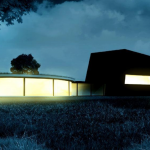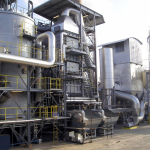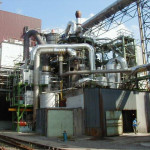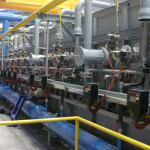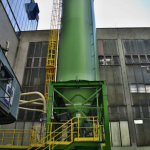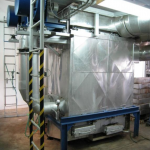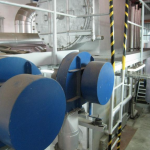Desulphurization DeSOx
In present many operators of coal-fired boilers are forced to comply with stricter emission limits in terms of SO2 concentration in the flue gases.
To reduce SO2 in flue gases to the required emission limits we design and deliver systems of dry sorption, which is based on injection of powdered sorbents on Ca2+ (etc. calcium oxide or hydrated lime) or Na+ (etc. sodium bicarbonate) basis. These sorbents are capable to neutralize acidic components in flue gases (such as HF, HCl and SO2). The required reduction is achieved by controlled injection of powdered sorbents.
Effective application of desulphurization systems requires the following process condtitions:
- suitable granulometry of sorbents,
- suitable operating temperature of flue gases,
- intense mixing between sorbents particles and pollutants,
- required residence time.
Main features of dry sorption:
- high efficiency and flexibility,
- completely dry process,
- simple technology,
- health safe sorbents,
- cost attractive method.
Please do not hesitate to contact us for more information. We also offer realization of full-scale operational tests, so you can easily verify efficiency and suitability of this technology for your unique process.
EVELINE – Up-to-date Waste-to-Energy Plant
Due to the current objectives plan of waste management of the Czech Republic, which provides specific measures for waste treatment in the Czech Republic, we come up with a modern concept of up-to-date waste-to-energy plants with small and medium capacities (WtE Plant).
Our target is to deliver such units with annual capacities ranging from 10 up to 30 kt, which:
- contribute to decentralization of heat and power generation
- reduce transportation costs of municipal waste from producers,
- offer a convenient alternative how to close the chain of producers and utilizators – effective waste-to-energy conception
Technical design of the small WtE Plant including steam production and subsequent power generation could be defined as follows:
- Annual capacity is about 10 000 t/a. This quantity is approximately produced on the territory of 20,000 to 25,000 inhabitants. WtE Plant can be equipped with one up to three equivalent lines, thus annual capacity of 30 kt in total.
- Natural gas used as a stabilizing and additional fuel.
- The generated steam is used for power production in a simple turbine working in Rankine cycle.
- Waste from a specific locality is deprived of non-incinerated particles, such as clay, stones, rubble, large pieces of metal, ash, etc.
- Estimated calorific value of municipal waste ranges between 8 and 10 MJ/kg.
- Working time is estimated to 8,000 hours/a.
The heart of the WtE Plant is a combustion chamber with reciprocating grate which allows incineration of municipal waste in wide range of composition. Ideal incineration process conditions are provided by controlled multi-stage injection of combustion air and by controlled speed of the grate. Flue gas temperature at the end of the combustion chamber, which is given by legislation, is maintained at 850°C, in case of non-standard conditions, by stabilization burner firing natural gas. The size and arrangement of the combustion chamber after last injection of combustion air is designed to ensure residence time of flue gases for 2 s at 850 °C. The combustion chamber is in two pass arrangement. Flue gases then enter a steam boiler where steam is generated at given parameters.
Flue gas cleaning system of the WtE Plant primarily uses the dry method of flue gas cleaning, secondarily the wet scrubbing. Wet scrubber may not be used in certain cases. Cleaned flue gases leave the WtE Plant by a stack.
Main features of small and medium size WtE Plants:
- significant contribution to energy self-sufficiency
- waste treatment at place of its origin,
- reliability, effective and relatively simple technology, which is designed to produce heat and power,
- balanced technical and economic solution.
Cleaning of exhaust and flue gases
We offer several types of exhaust and flue gas systems which are based on an appropriate combination of various physical-chemical processes. Flue gas cleaning system is designed as a tailor-made solution according to client’s requirements.
Gas cleaning system can include as follows:
- heat utilization (tubular and plate heat exchangers, recuperative heat exchangers, etc.)
- dedusting (fabric filters, electrostatic precipitators, vortex separators, multicyclones, etc.)
- reduction of pollutants (adsorption on carbon or zeolite sorbents, absorption methods, chemisorption)
- removal and disposal of combustible pollutants (combustors, combustors with ceramic grate, catalytic combustion)
- combined procedures (concentration of combustible pollutants by absorption and their subsequent thermal disposal)
Dioxins/Furans DeDiox
We offer a modern catalytic filtration system to destroy dioxins/furans in flue gases. Function of these systems combine principles of surface filtration and catalysis. Filtration elements are made from special cellular ceramics or high performance PTFE fibers equipped with PTFE membrane. In both cases catalyst based of TiO2/V2O5 is incorporated in the filtration material.
Significant advantages of the catalytic filtration system include integration of multiple unit operations within a single equipment (a catalytic filter). Primary operation is De-Dust + DeDiox (destruction of dioxins a furans), secondary operation is reduction of NOx, HCl, HF and SO2 by injection of suitable sorbents into the flue gas stream prior to the catalytic filter.
In present there are numbers of successful references in the world proving high efficiency, reliability and therefore bringing significant cost savings.
Our company has also implemented a number of successful projects in the Czech Republic and Slovakia – please see section Dioxins in References.
Retrofits and revamps
For retrofits and revamps of existing plants in process industry we apply the latest know how and experience to meet our clients requirements. Furthermore our approach guarantees that the retrofitted plant will achieve higher efficiency and will comply with legislation requirements.
Our approach includes:
- Analysis of existing situation and shape of the plant
- Measurement of technological and environmental parameters
- Conceptual design of retrofit
- Economic analysis of the proposed retrofit
- Detailed design and project documentation
- Building permit procedure
- Retrofit implementation
- Starting-up and evaluation
For industrial furnaces and units in thermal treatment processes, we offer burner systems for combustion liquid and gaseous fuels. In these systems we apply up-to-date burners of world’s leading producers. For special cases we use our own design of burners. Burner systems design is complex including all necessary heat distributions, exhausts, field instrumentation, regulation and other technological equipment (blowers, fans, chimneys, heat exchangers, etc.). Control system is built up by our professionals. We can provide burner testing at a modern burner testing facility.
Burner Systems
For industrial furnaces and units in thermal treatment processes, we offer burner systems for combustion liquid and gaseous fuels. In these systems we apply up-to-date burners of world’s leading producers. For special cases we use our own design of burners.
Burner systems design is complex including all necessary heat distributions, exhausts, field instrumentation, regulation and other technological equipment (blowers, fans, chimneys, heat exchangers, etc.). Control system is built up by our professionals.
We can provide burner testing at a modern burner testing facility.
We offer the following burners:
- burner for direct heating
- burner for direct heating using external preheating of combustion air
- burner for direct heating with own recuperator
- burner for direct heating with own regenerator
- burner for indirect heating with own recuperator
- burner for indirect heating with own regenerator
Energy from Biomass
EVECO Brno, in cooperation with a group of Czech companies and Brno University of Technology – Institute of process and environmental engineering, has developed a new technological unit for biomass combustion.
We offer highly efficient boilers with capacities from 1 to 5 MW, which are characterized by integration of proven technical solutions. The technology and total process optimization have been proven by calculations including simulation models using CFD methods.
Forms of energy produced by proposed technology:
- Warm and hot water boiler – Hot utility water
- Steam generation for various technological demands
- Cogeneration – combined heat and electricity generation
- Main advantages of technology are as follows:
- Low fuel consumption – due to high equipment efficiency
- Fully automatic operation – it guarantees high user comfort
- Versatility– various types of biomass combustion
- Independency – in case of cogeneration – unit can cover your heat and electricity needs
- Clean energy generation – biomass combustion is CO2 neutral
- Cost attractive solution – short payback period
All specific requirements can be tested during the project preparatory phase at the reference biomass unit. Experts from Czech Universities provide additional expertise as required.
Thermal treatment of sludge
Technological units for thermal treatment of sludge represent a complex and challenging task in terms of process engineering and environmental protection. Their design requires deep know-how and long-term experience from various engineering fields.
Technological units (sludge incinerators) destroy wide range of pollutants from industrial production. Pollutants occur in solid, liquid and gaseous phase. Sludge of extremely high humidity represents a specific case. Nevertheless even those can be effectively treated.
Sludge incinerators are mostly equipped with a multiple-hearth kiln or fluidized bed furnace for sludge incineration. Depending on the sludge composition flue gas cleaning systems can be based on completely dry, semi-dry or wet methods.
Sludge incinerator typically includes as follows:
- sludge pre-treatment (sludge dewatering, storage, etc.)
- sludge incineration (multiple hearth kiln, fluidized bed furnace, secondary combustion chamber, etc.)
- heat utilization (steam generator, thermal oil heater, hot water boiler, etc.)
- flue gas cleaning (dry, semi-dry or wet method, dioxin/furan removal, etc.)
- residues management (ash and fly-ash removal and closed storage, etc.)
- modern control and safety system
Waste management solutions – M.S.W. Energy Solution
We offer a revolutionary solution for recycling and emission-free conversion of waste to energy, which will help solve the problem of landfill sites and the disposal of hazardous materials;
Advanced sorting and recycling technology, which is able to sort 100% of mixed municipal waste effectively, with subsequent high energy efficiency;
Extremely energy-saving drying technology – closed circuit drying process with high efficiency levels;
We produce fuel with high heating values – High Quality Fuel (± 22 MJ/Kg);
Thermo-catalytic Gasification, technology with 90 % efficiency in conversion into energy, practically without waste;
Cleaning is carried out using the “O-Zone” (O3), currently the most advanced technology available for the ecological filtration of air, water, and gas;
National and socio-economic benefits of the project
Prevention of severe air and environmental pollution.
In the process of Thermo-Catalytic Gasification, no environmentally hazardous substances are produced.
The technology works without air or oxygen, combustion does not take place!
Our M.S.W. energy reduces the amount of waste to 5% of the original quantity, without the formation of hazardous substances.
We work with a 2.5 – 3 times higher efficiency than traditional combustion technology. The return on investment is less than 7 years.
From signing the contract to delivery and installation start, we need only 9-12 months.
Want to know more? Download product leaflet here or send us an email.





